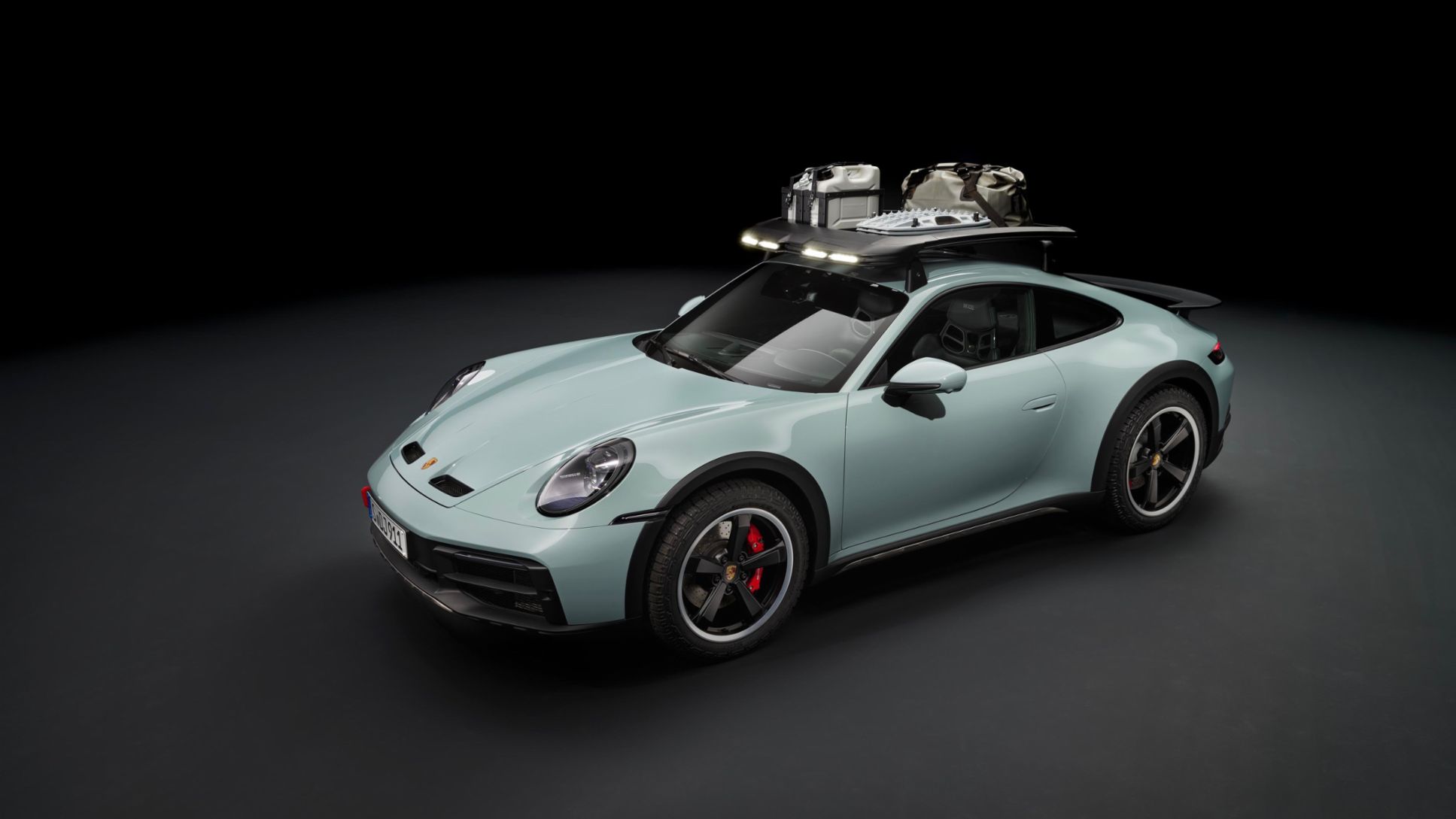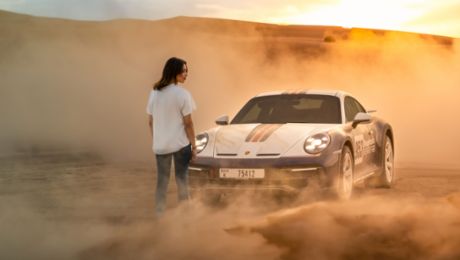The new Shade Green metallic paint makes its debut in the 911 Dakar. The car can also be ordered in three familiar colours: GT Silver Metallic, Black and White. The special colours of Ice Grey Metallic and Shark Blue are also available. The 19- and 20-inch Dakar wheels come standard in Black (satin finish) and are optionally available in Vesuvius Grey (satin finish) or White.
Inside, the standard full bucket seats and the absence of rear seats instantly catch the eye. The Shade Green colour is featured as a contrasting tone inside as well – in the contrasting seams for instance, as the 12-o’clock marker on the GT sports steering wheel in Race-Tex, on the dashboard trim and as the visible background of the Race-Tex centre panels of the seats. The dashboard features a badge with the individual build number of the vehicle. Porsche is building 2,500 examples of the 911 Dakar. The selector lever for the eight-speed PDK is made of aluminium, while the door sill guards feature black brushed aluminium and bear the 911 Dakar logo. Optionally, LED projectors in the doors, which project the 911 Dakar logo on the ground when the doors are opened, can be specified.

Rallye Design Package pays homage to the 1984 Paris-Dakar triumph
The Rallye Design Package is available as an option. It establishes a direct visual link to the Porsche team that won the Paris-Dakar Rally in 1984. The cars featured two-tone paintwork in blue and white, and had red and gold decorative stripes as decals. The new Rallye Design Package is painted with a two-tone White/Gentian Blue Metallic finish and features the “Roughroads” logo. The word evokes memories of days gone by, while also embodying the idea of the 911 Dakar: this is a car for rough roads. Porsche has registered the designation as a trademark.
The 911 Dakar with Rally Design Package is the first series-produced combination of dual-colour paint and adhesive film. New painting technology was developed and new work procedures established for the purpose. The manual masking and painting processes were also integrated into the series production process for vehicle painting. The large-scale film wrap is applied by hand by Porsche Exclusive Manufaktur.
In the Rallye Design Package, the rear spoiler and Dakar wheels are White. In the interior, the contrasting colour is Shark Blue instead of Shade Green. The safety belts also feature Shark Blue, as does the embroidered 911 logo in the headrests. Race-Tex material is also used generously in the Rallye Design Package, being additionally featured in the roof lining, on the dashboard, the sun visors and the floor mats. The interior trims and the decorative inlays on the dashboard and the interior door handles are in Ceramica White. Small LED projectors feature in the doors. They project the ‘Roughroads’ logo and the profile of the all-terrain tyres onto the ground when the doors are opened. The Rallye Design Package is available for €26,061 incl. VAT. The “Rallye Design extension package” can be ordered as an option for the vehicle interior. It includes additional details in Race-Tex including decorative stitching in Shark Blue – from the inner door sill trim to the fuse box cover and the vehicle document folder, to the central air vent housing with slats in leather. Another eye-catching feature is the interior mirror console clad in black Race-Tex with decorative stitching in the same shade of colour. The expansion package can be ordered at a price of €2,957.15 including VAT.
Three decal sets in the 1970s rally style
The rally history of the Porsche 911 well away from paved roads began before the first victory in the Paris-Dakar Rally in 1984. Early forays in the East African Safari Rally in the 1970s remain a strong memory. While the styling of the optional Rallye Design Package for the 911 Dakar draws heavily on the winning car of 1984, Porsche offers three exclusive wraps for the 911 Dakar that reprise the look of the 1971, 1974, and 1978 entrants in the East African Safari Rally.
This event took participants more than 5,000 km through savanna, desert scrubland and the highlands of Kenya and is regarded as one of the toughest rallies of all. Porsche undertook the challenge for the first time with a works team in 1971. Outwardly, the modified 911 S models were only identifiable by the simple black decals on the bonnet, the front wings and the doors. The Rallye 1971 decal set for the 911 Dakar revisits this design and adds the competition number 19, which belonged to the most successful 911 in this rally – a car that came fifth in 1971, driven by Polish drivers Sobiesław Zasada and Marian Bień. The decal set is available for €4,165.
The East African Safari Rally featured incredibly long stages – in 1974, the race was divided into three sections of 1,450 to 2,019 kilometres, which the teams had to complete in just five days. Of the 99 cars that entered, only 16 made it to the finish line. Swedish rally champion Björn Waldegård, who had already won the Rallye Monte Carlo twice in a Porsche, held the lead for a long while alongside co-driver Hans Thorszelius in the 911 Carrera 2.7 RS and started the third section with a 36-minute gap on second place. But a damaged wishbone cost him 72 minutes, and in the end Waldegård held on to finish second. Characteristic of the decals of the main sponsor were the blue stripes that traced the shoulder lines of the otherwise white car. The current wrap takes up this theme, albeit with narrower stripes and augmented by the Porsche logo on the lower edges of the doors. The Rallye 1974 decal set is available for €4,165.
Björn Waldegård wasn’t finished. With one of three 911 SC Group 4 cars custom built for the purpose, the Swede gave it another go in Kenya and quickly showed the competition that he was set on victory. In the end, however, the East African Safari Rally would again prove treacherous: wishbone, shock absorber, drive shaft – Waldegård’s Porsche sustained too much damage, in some cases far from helping hands. The speedy Swede had to be content with fourth place, while the South African duo of Vic Preston Jr. and John Lyall took second. The sponsor’s decals consisted of wave-shaped surfaces in orange and light and dark grey, familiar around the world thanks to the activities of the Martini Racing Team founded in 1958. Once again, Porsche designers have respectfully reinterpreted the historic decals here. The competition number 14 on the doors was that of second-placed Vic Preston Jr. The Rallye 1978 decal set is available for €5,950.


